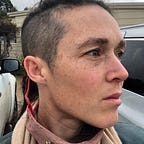Burning holes in seeds: a bead making journey begins
At Warlukurlangu artists, there was a little storeroom between the office space and the kitchenette which exited into the backyard. The backyard was no more than a covered square of concrete bordered on three sides by red dust and the arts centre building on the other. There was a small hut in the back that sometimes housed artists or visitors to the art gallery. And on the other side of the storeroom was the gallery space — a largish room with a large table stacked with painted canvases that we moved about for viewing when visitors flew in. I sat at that table once or twice taking notes while artists told me the story of what they had painted, the names of the places that were depicted, and the narratives that wound through them.
On a particular day I was asked to clean up the store room. That was the day that I found that long strand of ceremonial ininti, all those seeds strung on hair string the length of the entire gallery space and back. I held a section of that strand in each of my hands and felt the weight of it, the long hours of burning holes with a piece of bull wire. Of spinning hair into string.
I was 15 when I first arrived at Yuendumu by accident as a travelling performer with three families engaged in performing a language-less school play about domestic violence. I arrived there and never wanted to leave again, seeing the way their bodies attuned to the landscape just like mine did at home in the Wombat Forest where I grew up. I had never wondered why had I not seen this in any of those people around me that were supposed to be grown up and to know stuff about the world, until after I went to Yuendumu. And then, instead of just feeling crushed by school, my entire culture suddenly made no sense to me at all.
On that first visit to Yuendumu, I went with some of the women to watch the women’s ceremony as part of Sports Weekend. They spent all day preparing, grinding ochre, painting bodies, putting on headdresses, all the while singing and talking and laughing and telling off dogs and kids, and breast-feeding, and preparing their bodies and minds for what was to come. The ceremony didn’t start until well after nightfall and was a disappointing display of shuffling feet and keening song. But it stuck with me, and when I held that strand of ininti, I could feel all those hours of ritual embodiment, all the generations of knowing and being and tending, flowing into my hands.
When I left Yuendumu that first time, I took with me a jar of ininti, and used a pair of pliers to straighten out a wire coat hanger to use as a burning implement. I sat in the sand for a whole day and burned holes in ininti and then threaded them on a piece of wool — the closest thing I could find to hair string.
There is nothing quite like the smell of burning plant embryos to awaken the senses. I still burn almost all my seeds today, rather than drilling, for multiple reasons. One is the smell. Each seed emits a different scent when burnt and the scent and the smoke carry my prayers for the new life that is contained in each seed that transforms from a plant life to a a different kind of life when made into beads. And the smell and the smoke carry my prayers for everything that is dead and dying along with the plants that will never be because of my work. I burn seeds because burning them seals the embryonic seed walls and makes them more robust and long lasting. And I burn seeds because in all respect, if I am to damage a seed and denature it, then I prefer to do so in relationship with fire, rather than metal, which is cold and unfriendly but has its place.
I still don’t know what those long strands of ininti were used for. Perhaps it was the men, not the women, that made use of them in their ceremonies. Or they were made for a specific ceremony that was secret or lost to time. But making that first set of beads was an initiation of sorts. An entryway into the cycles of birth, death, decay and rebirth that form the foundation of our existence, and the basis of a healthy relationship with life.
To continue hearing about my bead-making journey, read the next chapter on wooden beads, called ’In the company of trees’.
